
As part of my role as Scottish correspondent for Groundtastic magazine I wrote a number of club articles dedicated to a particular stadium. I hugely enjoyed visiting new towns and cities to unearth some architectural gems of the football world. As a roving reporter I visited Tynecastle, Firs Park, Victoria Park, Borough Briggs, and completed a tour of the football grounds of the Highland League to name but a few.
I have recently been watching the vlogs of Footy Adventures, which I would heartily recommend to those of you who are interested in football stadiums and architecture. These vlogs are exactly the sort of thing that I would have been producing if things were different. Sadly, I have been held back by a progressive, genetic disease of the nervous system, the related disability, a lack of technical expertise to produce videos and being in Scotland at the wrong time, with the wrong person.
I suppose what I have done as an alternative is to write Every Silver Lining has a Cloud, which is an autobiographical tour of the Welsh Premier League football grounds. For those who have yet to read it – shame on you. I am happy with my own contribution to the world of football architecture, but I can’t help having feelings of envy and jealousy as I watch the ever increasing body of vlogs produced by Footy Adventures.
I have decided to reproduce the club articles and photographs that I managed to take during my time in Scotland. This was a difficult time for myself as I was beginning to feel the full effects of living with Friedreich’s Ataxia. It would obviously difficult having to rely on trains to get me to my desired destination and the fact that I was losing my dexterity meant that it was increasingly difficult to take decent photographs.
Thankfully, I have managed to find all of my photographs from my travels around the Highland League football grounds way back between the years 2002 – 2006. Much of the information about the grounds will have changed drastically. Indeed, the Highland League itself is now made up of a different line-up of clubs. I believe that this makes the snapshot that I have provided below, even more interesting to football ground enthusiasts. These articles were published in Groundtastic magazine 46-48 during 2006 and I would encourage everyone to subscribe to this excellent production.
Overall, I am happy with my contribution to the magazine, and hope the following is of interest to some of you. The articles appear in their original form, but I have updated some of the archaic website addresses that certain clubs had.
***
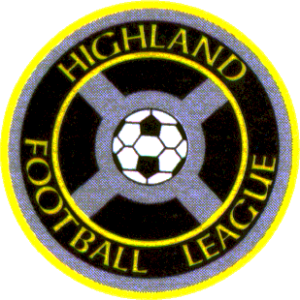
Over the next three issues I will be taking a brief look at the football grounds of the Highland League. Fifteen clubs ply their trade in this semi-professional league, which was first contested in 1893, when six of the member clubs were based in the environs of Inverness. Since then, of course, the competition has grown and nowadays Highland League football is contested throughout the northeast lowlands (Moray and Aberdeenshire), as far north as Caithness and as far as Lochaber to the South.
There are certain similarities between many of the grounds in the Highland League such as a penchant for top-level stands, the dominating presence of the social club and a failure to offer amenities on all sides of the ground. Despite a certain level of consistency each ground maintains it own unique character, which makes for a fascinating collection of grounds in a part of the country where you would least expect it.
Clachnacuddin – Grant Street Park
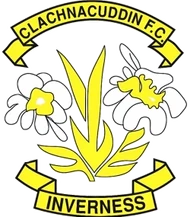
Clachnacuddin were formed in 1886. The name comes from the Gaelic for ‘Stone of the Tubs’, which refers to the stone where the washerwomen at the nearby River Ness used to beat washing dry.
Positioned in the middle of a council housing estate in the Merkinch area of Inverness, Grant Street Park (capacity 2,500) is one of the less scenic grounds in the Highland League. The barbed wire that tops the perimeter fencing tells you all you need to know about the surrounding area.
A drab, grey entrance leads to an uninspiring ground overlooked by houses.
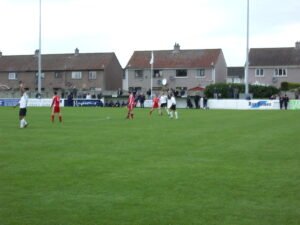
A small, newly built stand straddles the halfway line. This seats 154 spectators, but the colour of the seats, black and dark yellow, does little to lift gloomy spirits.

The opposite side of the pitch is an uncovered, grassy embankment distinguished only by the presence of the home and away dugouts.

The Social Club End is dominated by the food bar, toilets, changing rooms and, funnily enough, the social club – a key source of revenue for most Highland League clubs.
Behind the opposite goal is a covered terrace, which is about ten steps deep. This structure includes a row of supports that run across the front of the terrace that impair the view of the few that stand there.
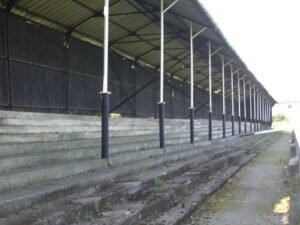
Eight floodlights, each with six lamps attached to unimaginative poles, light the ground.
For more information on Clachnacuddin, click here.
Nairn County – Station Park
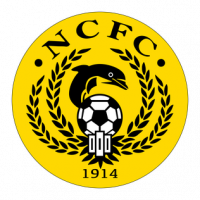
Formed in 1914, ‘The Wee County’ play their home games at Station Park, originally named due to its proximity to the town’s railway station.
This neat ground has a capacity of 3,800 and boasts two covered stands running along each side of the pitch.

The Main Stand, which dates from 1936, is a small wooden structure. Depending on where you sit, your view of the action may be hampered by the vertical supports that hold the stand in place. Instead of plastic seats supporters park themselves on wooden benches. 250 fans can squeeze into this structure.
Directly opposite is the ‘Cow Shed’. This is a long, covered terrace filled with large wooden roof supports, the size of tree trunks, running along the front and rear.
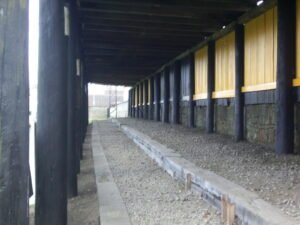
Behind each goal is a stone chip path that leads from the turnstiles right around the luscious green pitch, which is regarded as one of the finest in northern Scotland. This is a refreshing change as most Highland League clubs play on quagmires.
There are eight floodlights at the ground – four large yellow and black pylons each with six lamps on and four smaller, wooden pylons with two lamps on.
Portakabins are used for club offices, toilets and refreshments and are positioned just inside the main entrance.
For more information on Nairn County FC, click here.
Forres Mechanics – Mosset Park
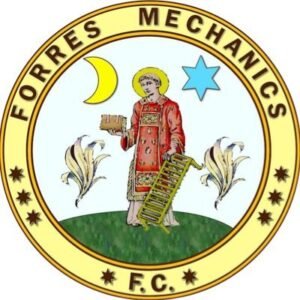
Forres Mechanics were formed in 1884, were founder members of the Highland League and have played at Mosset Park since 1897.
Today, the ground is dominated by the impressive Main Stand. The busy A96 [Inverness-Aberdeen road] runs directly behind this top-level stand that seats 540 supporters. Underneath the seated area, the stand houses the dressing rooms, boardroom, toilets and refreshment stall.

To the right of the stand is a small, sturdy iron shelter that protects disabled supporters – and those who have forgotten their umbrellas – from the often hostile Highland weather. While this structure will never win any architectural prizes for design it does provide welcome shelter, which is more than can be said for the other three sides of the ground.

Opposite the stand is an uncovered grassy embankment overlooked by houses.
It is a similar story behind both goals. A lack of amenities and simple grassy, often muddy, embankments means these ends are only really populated when the sun is shining.
I particularly like the design of the dug outs at Mosset Park with the chunky lettering leaving you in no doubt who sits where.

The overall ground capacity is 6,540.
For more information on Forres Mechanics, click here.
Lossiemouth – Grant Park

Grant Park (capacity 3,500) is home to a 250-seat wooden Main Stand with windbreaks. This stand is similar to many in the Highland League in size and top-level entry style. By all accounts it is uncomfortable with a poor view.
Opposite this modest structure is a small covered terrace area, which rather resembles a bus shelter. It was erected in 1993.
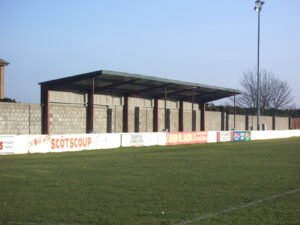
The far end of the ground is closed off with only rusty corrugated iron standing behind the goal.
I was positioned behind the opposite goal after gaining entry into the ground through the official players entrance. I use a wheelchair so I couldn’t get through the turnstiles. Instead I had to wheel past the dilapidated looking dressing rooms and barren boardroom before reaching pitch side. I found a steep, muddy bank behind the goal as well as a small portakabin, which was used as a club shop.
In the far corner stands the most interesting structure in the ground – a small pavilion that originally housed the changing rooms. This wooden building is now used to sell refreshments from the front and includes toilets – for the “Gents” anyway – at the back.
Grant Park is a rather run down ground that doesn’t seem to have had a lick of paint since it was opened in circa 1947, but this gives it a certain appeal to me. I would much prefer to watch football in a ground full of character and quirkiness than a plastic, new build full of empty seats.
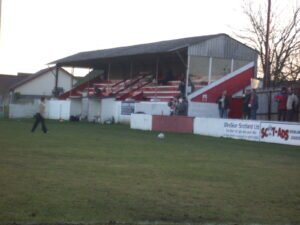
For more information on Lossiemouth FC, click here.
Rothes – Mackessack Park

The town of Rothes is situated ten miles South of Elgin on the A941 and is home to a number of whiskey distilleries and associated industries. This is handy as anyone watching Rothes FC regularly this season would have needed more than a few drams to help them sleep at night. At the time of writing, Rothes are 13th in the Highland League with only 22 points from 24 games and a goal difference of –32.
Home to Rothes since they were admitted to the Highland League in 1938, Mackessack Park stands amidst rolling hills by the side of the River Spey (hence the club nickname of ‘The Speysiders’). It really is a lovely setting but this is a double-edged sword as between September 2004 and late February 2005, Rothes only played one home game thanks to the incessant waterlogging that dogged the club. There were similar problems during 2005/06.
The ground is home to a small stand (capacity 160) with just four rows of seats. The other three sides of the pitch are simply small grass embankments, which offer no shelter from the elements but some pleasant views of rolling hills. The total capacity for the ground is 2,650.
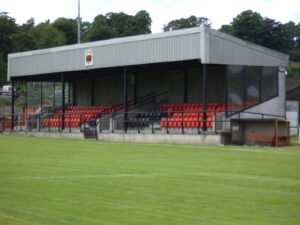
Mackessack Park wins plus points for its beautiful surroundings and boasts four sets of single pole floodlights, each with eight lamps on, which run down both sides of the pitch.
The dugouts look rather tired but while you can’t imagine Sir Alex parking his rear on this glorified park bench, they serve their purpose at this level.

For more information on Rothes FC, click here.
***
For more information on the Highland League, click here.
Thanks to Kenny MacLeod, Alan McIntosh and Easton Thain for their co-operation with this article.

